Comparisons of Shinto with other traditions often prove illuminating, and we’re lucky to have among the readership someone with expertise in the Greek tradition – Erik, author of the now-retired ExecutivePagan blog where some of the material for the article below originally appeared in 2007.
(There’s a very interesting news feature about the revival of the old Greek gods at this link.)
“””””””””””””””””””””””””””””””””””””””””””””””””””””””””””””””””””””
“If you have ever come on a dense wood of ancient trees that have risen to an exceptional height, shutting out all sight of the sky with one thick screen of branches upon another, the loftiness of the forest, the seclusion of the spot, your sense of wonderment at finding so deep and unbroken a gloom out of doors, will persuade you of the presence of a deity. Any cave in which the rocks have been eroded deep into the mountain resting on it, its hollowing out into a cavern of impressive extent not produced by the labours of men but the result of the processes of nature, will strike into your soul some kind of inkling of the divine. We venerate the source of important streams; places where a mighty river bursts suddenly from hiding are provided with altars; hot springs are objects of worship; the darkness or unfathomable depth of pools has made their waters sacred.“ – Seneca the Younger (Campbell, Robin, ed. Letters From a Stoic. New York: Penguin, 1969)
&&&&&&&&&& — — — &&&&&&&&&&
My name is Erik and I am a modern Hellenic polytheist; I worship the ancestral gods of my (American, Western-European-descended) culture. This article looks at both ancient and modern Hellenismos (the term most commonly used to denote the religious and cultural inheritance of ancient Greece) and compares them with modern Shinto – a somewhat limited perspective, I realize, but I don’t know enough about ancient Shinto to be able to include that in my scope. And in any case, modern Shinto as it is lived and practiced today is what I’m really interested in when I look to it for possible inspiration. My own faith and practice have been influenced by my study of Shinto, and I am very pleased to be able to share some aspects of this with the readers here at Green Shinto.
Pollution and Purification
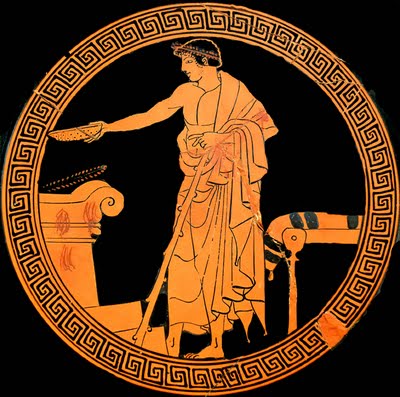
Libation, Greek style (copyright unknown)
I want to start where I first noticed congruity between these two traditions – ritual pollution (miasma / kegare) and purification (katharsis /oharae). There is some dispute over the degree of emphasis that the ancient Greeks placed on miasma, or “pollution”, as well as to the forms and occasions of it (a dispute likely due, at least in part, to the intensely regional nature of much of ancient Greek religious practice). However, it is clear that they recognized it as a legitimate source of spiritual danger; this is attested in at least a handful of sources. Here are two, just as a sampling:
“Never omit to wash your hands before you pour to Zeus and to the other gods the morning offering of sparkling wine; they will not hear your prayers, but spit them back.” – Hesiod, Works and Days, lines 722-725
“Never pass through, on foot, a lovely brook of ever-flowing water, till you pray and look into the beauty of the stream, and in her clean, sweet water, wash your hands. For if you cross a river with your hands and crimes uncleansed, the gods will punish you, and bring you countless pain in future times.” – ibid., lines 740-46 1
“…and with hands unwashed I would take shame to pour the glittering wine to Zeus; there is no means for a man to pray to the dark-misted son of Kronos, with blood and muck all spattered upon him.” – Iliad, 6.266-8 2
Historians of Greek religion have also noted this phenomenon: Walter Burkert devotes pages 75-84 of his “Greek Religion” to a discussion of purification3, and Robert Parker wrote an entire book on the subject4.
All that being said, Parker also points out that while there is evidence of a certain preoccupation with miasma and related topics in the historians and tragedians, as well as in Hesiod and Homer, there is relatively little other evidence to indicate whether this reflects an actual widespread cultural preoccupation, or just a recurring literary motif (ibid., pp. 12-16).
It seems appropriate, then, that we find in modern Hellenismos as well a range of attitudes and approaches to the question of purification. Some of us are concerned not to “come before the gods with unwashed hands” – a good example of this school of thought is the excellent book Kharis: Hellenic Polytheism Explored, by modern practitioner Sarah Winter, which emphasizes the importance of ritual purification (see especially pp. 56-57 (NB: page numbers refer to the first edition)). Others don’t seem to put as much emphasis on it – for instance, Rob Andrews’ useful how-to website Sponde! – Hands-on Hellenism mentions it not at all in the pages on prayer and libation.
Then, as now, “the most widespread means of purification is water” (Burkert, p. 76) – and this is also true in Shinto. Burkert speaks of vessels of khernips (lustral water that is either pure by virtue of its source, or made pure by various methods) being set up at the entrance to sanctuaries; and one of the most iconic images associated with Shinto shrines – surely second only to the famous torii gates – is the temizuya, the water basin or trough where visitors pause to purify themselves before approaching the sanctuary.
The observant reader may notice that I’ve been talking about purification exclusively in physical terms; this points up one of the deepest similarities between the two traditions, one that justifies all these words much more than a simple coincidence of ritual actions could do.
In both Shinto and Hellenic religion, impurity is mainly considered to be a temporary condition; one that can be resolved by symbolic physical cleansing when performed with the correct spiritual orientation and attitude. (Both traditions also recognize more serious forms of defilement, but those are outside the scope of this discussion.) This is in decided contrast to the pan-Abrahamic notion of “sin” as a spiritual state that can be temporarily alleviated but never cured, and even more to the specifically Christian idea that defilement is the natural state of the human race, and that it can only be remedied through divine intervention.
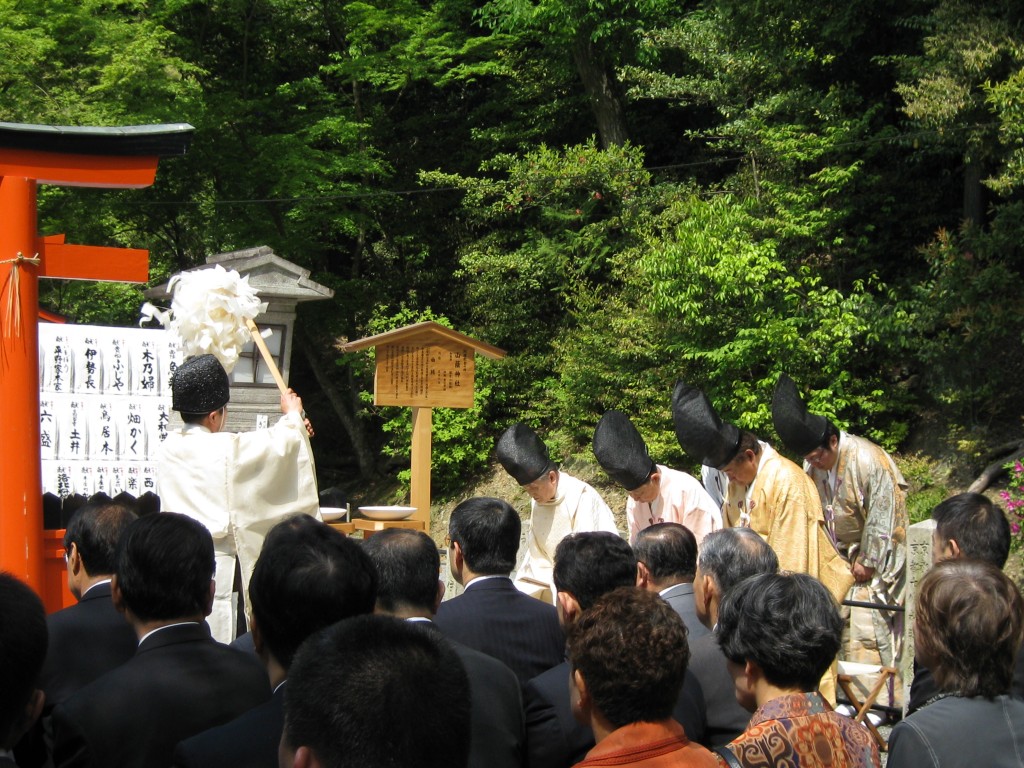
Purification at Yoshida Jinja, first for the priests attending then for the audience
Christian baptism is about purification, it’s true, but the difference is that in the traditional Christian view we are born inherently and ineradicably polluted due to the original sin of the first humans, and baptism is thus meant to save us from our natural condition by providing the only possible escape from this pollution, in the form of externally bestowed divine forgiveness.
My understanding of oharae and katharsis, on the other hand, is that they *restore* us to our natural condition by removing the pollution that we have accumulated over time. I think the difference is significant.
There are, of course, differences in the outlook of the two traditions as well, and in some cases these are also significant. Traditional Hellenic religion held that life was basically hard, and – unless you were exceptionally good, or exceptionally evil – the most you had to look forward to in the afterlife was an eternity as a specter in gloomy, lifeless Hades (there is a wide range of opinion on the afterlife question in modern Hellenism, from the traditionalist to the agnostic). The basic outlook of Shinto is much more hopeful – this life is a blessing from the kami, and “Man is a child of kami. He is also inherently good.”5 (Ono, p. 103) In this view, the natural state of the soul is that of purity; but pollution collects on it through the course of normal living as dust collects on a mirror, and it needs frequent washing to stay clean and bright, and thus truly reflect the image of the divine.
According to Yamakage Motohisa, Shinto priest and author:
“When the physical body is made clean by water, our heart and mind are purified at the same time. The act of washing our hands before worshiping at a shrine is about more than the magical cleansing power of water. We also make a distinction within ourselves between the secular and the sacred by that act, and thus we change our attitude and our mindset. In so doing, we wash away uncleanness. We purify our heart and mind so that we may connect with the spirit of Kami with a heart and mind that is clean, bright, right and straight. This is the most important goal of misogi.”6
I said at the beginning of this article that I was inspired to write by my belief that we Western Pagans can learn from the example and experience of Shinto. On this subject, I have been strongly influenced to make the effort to always purify myself before prayer; my view of the nature of miasma is also growing more toward a Shinto feeling.
In addition to the philosophic similarities, there are also striking correspondences between the physical aspects of worship in Shinto and Hellenismos, only the greatest of which can be included. (Please see pt. 2.)
**************************************************************************************
[1] Wender, Dorothea (trans). Hesiod and Theognis. Penguin, 1976.
[2] Latimore, Richmond (trans). The Iliad of Homer. U of Chicago P, 1961.
[3] Burkert, Walter. Greek Religion (2nd ed). Harvard UP, 2006.
[4] Parker, Robert. Miasma: Pollution and Purification in Early Greek Religion. Oxford UP, 1983.
[5] Ono, Sokyo. Shinto: the Kami Way. Tuttle, 1962.
[6] Yamakage, Motohisa. The Essence of Shinto: Japan’s Spiritual Heart. Kodansha, 2006.
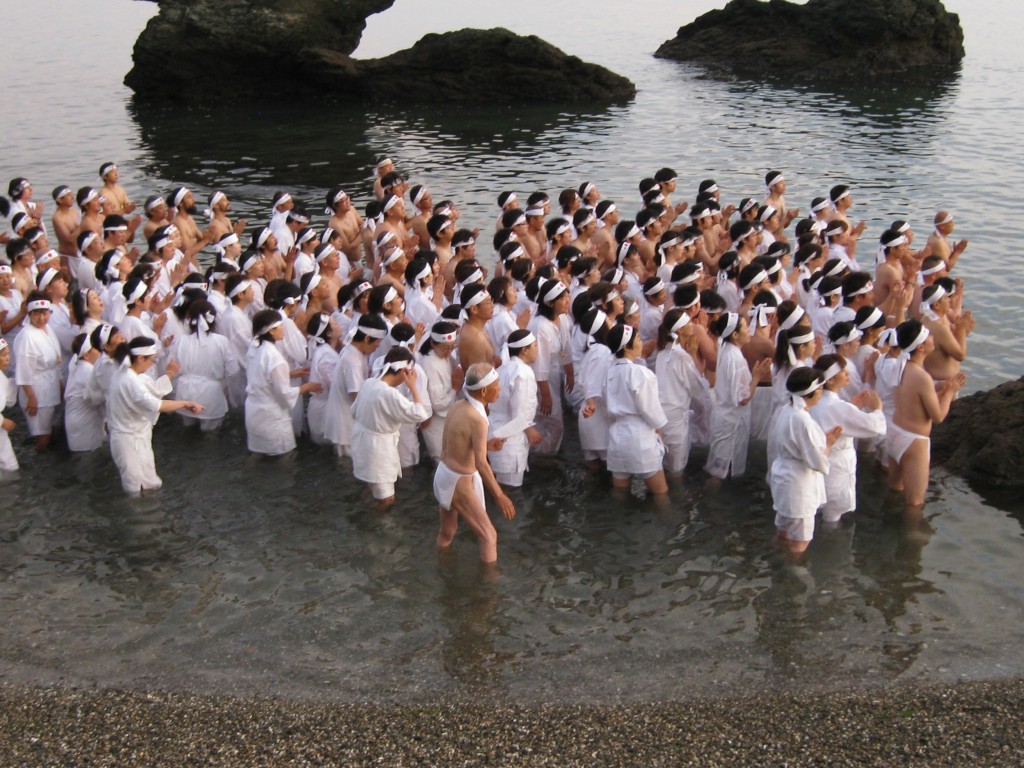
Mass misogi on the summer solstice near Ise

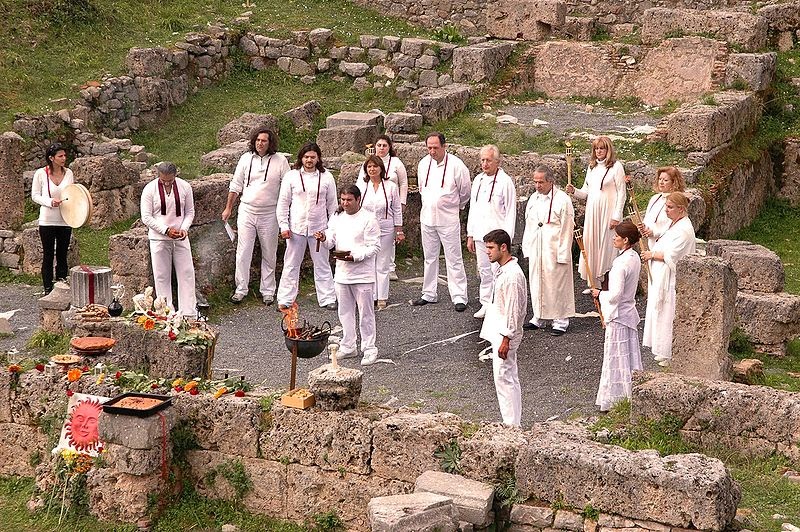
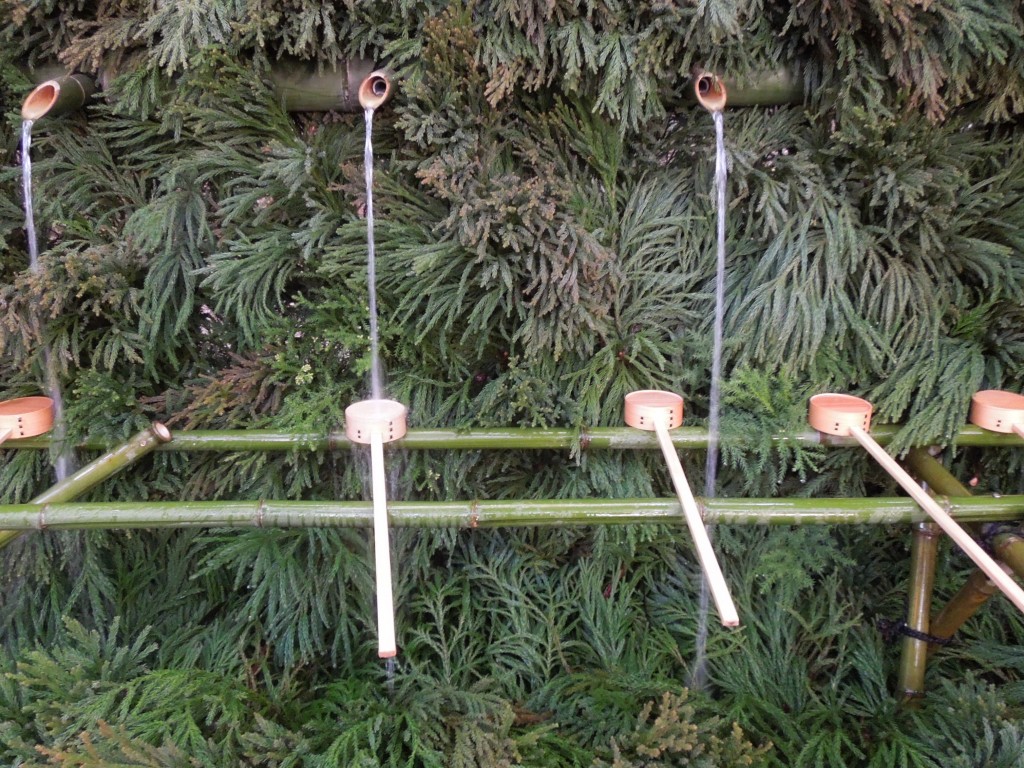
I don’t agree:
https://hellenismos.org/2016/04/07/purification/